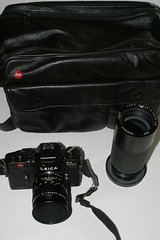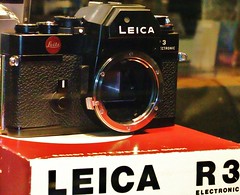Leica R3
| Leica R3 |
|---|
|
Maker: Leica Dates: 1976-1979 Variants: R3, R3 MOT Camera Type: 35mm SLR Focusing: manual Lens mount: Leica R bayonet Shutter: Electronic vertical metal blade focal plane Exposure meter: TTL selective/centre weighted Exposure modes: Manual, aperture priority ASA/ISO range: Finder screen: Ground glass Flash shoe: Hotshoe Flash speed: 1/90 TTL Flash: No Motor drive: No (R3 MOT yes, winder) Battery: 2×silver oxide Weight: 780g Number produced: |
Leica launched the Leica R3 in 1976. It was the successor of the Leicaflex SL2, developed in cooperation with Minolta along with the Minolta XE. Visually very similar to the Minolta camera it incorporated Leica developed light metering.
At a very difficult time for the company, the R3 was a commercial success ensuring continuation of the R system.
R3 Electronic
The first series of cameras were made in Germany before production was moved to the new factory in Portugal. This was the first Leica made camera with electronic exposure control and proved extremely reliable.
Viewfinder
Viewfinder display includes:
- Exposure mode A (automatic) or shutter speed (manual)
- Selected aperture
- Metered shutter speed
Shutter
Copal Leitz CLS electronic metal bladed:
- Manual - whole stops from 4s to 1/1000s, X flash sync 1/90s, B "bulb" (X & B also usable without power)
- Automatic - stepless from 4s to 1/1000s
Metering
Single cell in camera base for selective measurement, light reflected down by a secondary mirror behind the main mirror similar to SL / SL2. Two cells on the pentaprism for integrated "centre weighted" measurement. Electronic selection of either measurement in both exposure modes.
R3 MOT Electronic

|
| Leica R3 MOT Electronic image by JBAdams (Image rights) |
Near the end of production a version of the camera was released capable of being fitted with a motor winder made by Eumig. Like the first batch of 2,000 cameras, the R3 MOT was made in Germany.
Links

|
| R3 image by rst12 (Image rights) |
- Leica R3 Electronic user manual at Butkus.org
- Leica R3 MOT Electronic user manual at Butkus.org
- Leica R3 on www.collection-appareils.fr by Sylvain Halgand (in French)
